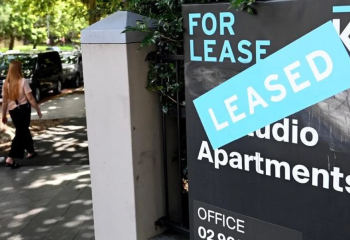
As the rental crisis bites, there are growing calls to strengthen tenants’ rights through rent freezes and caps, however experts warn these measures are likely to make the problem worse.
Renters continue to face rising rents and limited alternative homes to move into amid Australia’s rental housing emergency.
The Greens and other groups are calling on governments to introduce a two-year national rent freeze, followed by ongoing caps limiting rent increases to 2% every two years, among other measures to help renters.
However, Grattan Institute Economic Policy Program Director Brendan Coates believes the Greens’ proposed rent freeze and caps could do more harm than good.
He said rent freezes benefit existing renters in the short-term but could increase rates of homelessness for people in less secure accommodation.
In a scarce housing market like today’s rental market, a rent freeze would drive lower turnover and less availability of new rental accommodation.
“The reason why rents are rising is because housing is scarce,” Mr Coates said.
“Vacancy rates are at historic lows and so if you freeze rents, you actually worsen the rental crisis for anyone looking for a home.
“In the short term, we need to find a way to get people to economise the amount of housing that they occupy. Otherwise, the alternative is increased rates of homelessness because people can’t find homes.”
Mr Coates said an alternative solution would be to increase rent assistance in the short term, and increase the housing supply over the long term.
Proptrack Economist Angus Moore said rent freezes have other pernicious side effects.
He said evidence from San Francisco in the US showed that rent freezes incentivised landlords to remove properties from the rental market by redeveloping them for owner-occupiers.
Landlords also redeveloped properties into new buildings since new buildings were exempt from rent controls in that case.
Mr Moore said we may end up with fewer rental properties and less rental availability over the long term, making it worse for renters.
“There is also evidence from Massachusetts suggesting that rent caps and freezes lead to underinvestment in rental properties from landlords because the returns are capped,” he said.
“So landlords respond by reducing investment in minor maintenance like painting and new carpets, which leads to an overall lower standard of rental stock than would otherwise be the case.”
Real Estate Institute of Australia President Hayden Groves said the continued politicking around rental affordability is causing further confusion for Australians and adversely impacting housing supply.
“At a time when cost of living, inflation and interest rates are challenging for all, family investors are rightly frightened by talk of rent controls and rent freezes and we see that bearing out in the listings and sales data,” said Mr Groves.
“The biggest loser out of that is, of course, renters as fewer rental properties will be available.”
What do rental reform advocates want?
Last month, a coalition of more than 80 housing services and community groups across Australia called on federal, state and territory governments to establish minimum standards for renting laws nationwide.
The group, led by National Association of Renters’ Organisation (NARO), is calling for fair limits on rent increases, ending no-cause evictions and other rental measures.
“There has never been a better opportunity for the country to work together to bring greater stability, safety and security to the millions of renting households nationwide,” said National Association of Renters’ Organisation (NARO) Convenor Penny Carr.
“This will lead to better health, education and employment outcomes for renters as well as benefits to our whole community.”
It comes as the Greens continue to push the federal government to offer funding to the states and territories for similar rental measures, including its two-year freeze on rent increases.
Other measures include limiting the amount and the frequency of future increases and an end to no-grounds evictions.
The party wants to attach any rent control to the property rather than the lease to ensure there is no incentive for a landlord to evict a tenant, as well as giving renters a right to request ‘European-style’ long-term leases.
“Every person evicted out of their rental because they can’t afford the rent increase, is another person that may join the growing queues for public housing, so unless we cap rents, tackling the housing crisis will be almost impossible,” said Max Chandler-Mather, Greens Spokesperson for Housing and Homelessness.
The Greens have said they will pass the Housing Australia Future Fund (HAFF) bill in October if the federal government coordinates these reforms at National Cabinet and commits to investing $2.5 billion into public housing.
Rent rules in Australia
Currently landlords can increase rents every six months in Western Australia and Northern Territory, while the other states allow landlords to raise rents every 12 months.
The states and territories do not directly regulate the amount of rent that a landlord can charge when letting a property.
However, tenants in Victoria can make complaints about excessive rent increases to Consumer Affairs Victoria and try to appeal them at a tribunal.
In the ACT, there is a ‘guideline’ that means landlords must apply to a tribunal to prove that their rental increase is not excessive if it passes a certain threshold.
The threshold is more than 110% of the percentage increase in the ACT consumer price index for rents during the period. The guideline puts the onus on the landlord to explain above-guideline increases.
The introduction of a rent freeze would mean landlords will not able to increase rents for tenants for a certain period, according to the Australian Housing and Urban Research Institute (AHURI).
A rent cap would limit how often rents are increased, how much they can be increased by or a combination of both.
Australia’s rental landscape
Australia’s rental market remains extremely tight, with vacancy rates sitting at historical lows around 1.5% and rents climbing almost 12% over the year to June, according to PropTrack.
Nationally, the median weekly advertised rent increased 11.8% to $520 per week during the year to June.
Rents rose 8.1% over the same period during the prior year.
About 30% of households in Australia rent their home, with 27% renting from a private landlord, according to the REIA.
There have been low levels of new investment in housing, keeping the supply of available rental homes relatively low.
Additionally, Australia saw a rapid rebound in the number of people arriving in the country last year, driving the national population 1.9% higher in 2022.
Sourced from realestate.com.au




